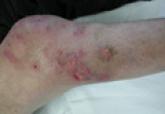Nocardia species are Gram-positive filamentous saprophytes that are indigenous to the soil of a large part of the United States.1 Although the genus harbors the potential to be pathogenic in humans, infections by this genus are uncommon, especially in immunocompetent hosts. Most nocardial infections in humans result from Nocardia asteroides,1-4 an organism often associated with multifocal lesions affecting more than one organ system via hematogenous seeding. On the other hand, infection with Nocardia brasiliensis is more likely to have cutaneous manifestations.1 There have been a few case reports of N brasiliensis in immunocompetent patients.1,2,5,6 We present a case of lymphocutaneous N brasiliensis infection contracted from commercially treated lumber in an immunocompetent patient. To our knowledge, this is the first reported case of cutaneous nocardiosis from commercially treated raw materials.
An otherwise-healthy 43-year-old man presented to our medical facility complaining of pain and swelling of his left hand. One week prior to presentation, the man's left ring finger was punctured by a large splinter from pressure-treated stained lumber. At the time of his injury, the man removed the wood from his hand; he treated himself further with soap, water, and hydrogen peroxide when he returned to his home. The patient was seen 3 days later at an outside clinic for increasing pain and redness over his left ring finger. A course of oral antibiotics (500-mg cephalexin twice daily) was initiated. The digit showed no improvement despite 4 days of oral antibiotics, and the man was referred to our institution for further care.
At presentation to our facility, the patient was afebrile but had a draining 1-cm lesion over the dorsoulnar side of his left ring finger, erythema extending over the extensor surface of the forearm, and tender subcutaneous nodules with epitrochlear lymphadenopathy (Figure). His laboratory values revealed a white blood cell count of 9700/µL, an erythrocyte sedimentation rate of 15 mm/h, and a C-reactive protein level of 2.39 mg/L. Incision and drainage with local debridement revealed a thick white purulence that was sent for culture and analysis with Gram stain. The patient was admitted to the hospital and placed on intravenous antibiotics (3.375 g of piperacillin-tazobactam 4 times daily) awaiting organism identification. No organisms were seen under a Gram stain.
Over the next 3 days, the patient had no clinical improvement in either his pain or erythema, necessitating a repeat debridement. On this debridement, we did not notice a focal recollection of purulence or necrotic tissue. We also performed further testing to investigate the potential that our patient was immunocompromised. All tests for systemic disease that would cause immune compromise revealed negative results. Four days after the patient's original debridement, cultures revealed a partially acid-fast, Gram-positive rod identified as N brasiliensis. The patient was started on oral trimethoprim-sulfamethoxazole (160-mg trimethoprim and 800-mg sulfamethoxazole), one tablet twice daily. With the initiation of this oral regimen, there was a dramatic improvement in his clinical condition, leading to discharge from the hospital 4 days later. This oral regimen was maintained for 4 months. At the patient's 8-month follow-up appointment, he demonstrated complete healing, absence of any functional deficit, and no recurrence of disease.
Bacteria of the genus Nocardia have several known pathogenic species in humans: N asteroides, N brasiliensis, Nocardia caviae, Nocardia madurae, and Nocardia otitidiscaviarium.1,7N asteroides is the most common pathogen and accounts for 90% of nocardial infections.8 While other species are more prone to systemic infections, N brasiliensis most often is a cutaneous disease that may occur as a superficial cellulitis, abscess, mycetoma, or lymphocutaneous infection.6,7 Also unlike other species, N brasiliensis is more likely to cause a primary infection than to behave as an opportunistic invader.6 Worldwide, N brasiliensis is a fairly common pathogen and is responsible for more than 90% of mycetomas in countries such as Mexico.7
Primary lymphocutaneous infection with N brasiliensis is an uncommon diagnosis in the United States. Most reported US cases are from Texas, California, and the southeastern states.1 When N brasiliensis is isolated as the infectious organism, it is often from hand injuries in otherwise-healthy individuals.8 Cutaneous manifestations may be underrecognized because of their resemblance to Sporothrix infection. When treated with potassium iodide, the common treatment for Sporothrix infections, Nocardia may begin to resolve.9,10
Cutaneous lesions caused by Nocardia form tender subcutaneous nodules that spread up the extremity in a linear fashion. These lesions also may produce sulfurlike granules similar to sporotrichosis. It is not unusual to see secondary skip-type lesions more proximal in the affected extremity.2,3,9,11


